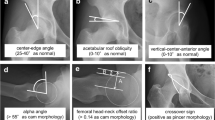Abstract
Objective
The purpose of this study was to compare the findings on hip MR arthrography (MRA) with the published MRA and arthroscopic classifications of hip labral tears and to evaluate a clock-face method for localizing hip labral tears.
Design/patients
We retrospectively reviewed 65 hip MRA studies with correlative hip arthroscopies. Each labrum was evaluated on MRA using the classification system of Czerny and an MRA modification of the Lage arthroscopic classification. In addition, each tear was localized on MRA by using a clock-face description where 6 o’clock was the transverse ligament and 3 o’clock was anterior. These MRA findings were then correlated with the arthroscopic findings using the clock-face method of localization and the Lage arthroscopic classification of labral tears.
Results
At MRA, there were 42 Czerny grade 2 and 23 grade 3 labral tears and 22 MRA Lage type 1, 11 type 2, 22 type 3 and 10 type 4 tears. At arthroscopy, there were 10 Lage type 1 flap tears, 20 Lage type 2 fibrillated tears, 18 Lage type 3 longitudinal peripheral tears and 17 Lage type 4 unstable tears. The Czerny MRA classification and the modified MRA Lage classification had borderline correlation with the arthroscopic Lage classification. Localization of the tears using a clock-face description was within 1 o’clock of the arthroscopic localization of the tears in 85% of the patients.
Conclusions
The Lage classification, which is the only published arthroscopic classification system for hip labral tears, does not correlate well with the Czerny MRA or an MRA modification of the Lage classification. Using a clock-face description to localize tears provides a way to accurately localize a labral tear and define its extent.








Similar content being viewed by others
References
Czerny C, Hofmann S, Neuhold A, Tschauner C, Engel A, Techt MP, et al. Lesions of the acetabular labrum: accuracy of MR imaging and MR arthrography in detection and staging. Radiology 1996;200:225–30.
Hodler J, Yu JS, Goodwin D, Haghighi P, Trudell D, Resnick D. MR Arthrography of the hip: improved imaging of the acetabular labrum with histologic correlation in cadavers. AJR 1995;165:887–91.
Petersilge CA, Haque MA, Petersilge WJ, Lewin JS, Lieberman JM, Buly R. Acetabular labral tears: evaluation with MR arthrography. Radiology 1996;200:231–35.
Fitzgerald Jr. RH. Acetabular labrum tears; diagnosis and treatment. Clin Orthop 1995;311:60–8.
Petersilge CA. From the RSNA refresher courses: chronic adult hip pain: MR arthrography of the hip. Radiographics 2000;20:S43–S52.
Petersilge CA. MR arthrography for evaluation of the acetabular labrum. Skeletal Radiol 2001;30:423–30.
Lage LA, Patel JV, Viller RN. The acetabular labral tear: an arthroscopic classification. Arthroscopy 1996;12:269–72.
Dorrell JH, Catterall A. The torn acetabular labrum. J Bone Joint Surg 1986;68-B:400–3.
McCarthy J, Noble P, Aluisio FV, Schuck M, Wright J, Lee J. Anatomy, pathologic features, and treatment of acetabular labral tears. Clin Orthop 2003;406:38–47.
McCarthy JC, Busconi B. The role of hip athroscopy in the diagnosis and treatment of hip disease. Otrhopedics 1995;18:753–6.
Hase T, Ueo T. Acetabular labral tear: arthroscopic diagnosis and treatment. Arthroscopy 1999;15:138–41.
Ikeda T, Awaya G, Suzuki S, Okada Y, Tada H. Torn acetabular labrum in young patients: arthroscopic diagnosis and management. J Bone Joint Surg 1988;70-B:13–16.
Mohana-Borges AVR,Chung C, Resnick D. Superior labral anteroposterior tear: classification and diagnosis on MRI and MR arthrography. AJR 2003;181:1449–62.
Leunig M, Podeszwa D, Beck M, Werlen S, Ganz R. Magnetic resonance arthrography of labral disorders in hips with dysplasia and impingment. Clin Orthop 2004;418:74–80.
Czerny C, Hofmann S, Urban M, Tschauner C, Neuhold A, Pretterklieber M, et al. MR arthrography of the adult acetabular capsular-labral complex: correlation with surgery and anatomy. AJR Am J Roentgenol 1999;173:345–9.
Petersilge C. Imaging of the acetabular labrum. Magn Reson Imaging Clin N Am 2005;13:641–52.
Rubin DA, Paletta GA. Current concepts and controversies in meniscal imaging. Magn Reson Imaging Clin N Am 2000;8:243–70.
Bencardino JT, Beltran J, Rosenberg ZS, Rokito A, Schmahmann S, Mota J, et al. Superior labrum anterior-posterior lesions: diagnosis with MR arthrography of the shoulder. Radiology 2000;214:267–71.
Author information
Authors and Affiliations
Corresponding author
Rights and permissions
About this article
Cite this article
Blankenbaker, D.G., De Smet, A.A., Keene, J.S. et al. Classification and localization of acetabular labral tears. Skeletal Radiol 36, 391–397 (2007). https://doi.org/10.1007/s00256-006-0240-z
Received:
Revised:
Accepted:
Published:
Issue Date:
DOI: https://doi.org/10.1007/s00256-006-0240-z




